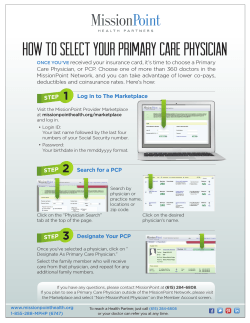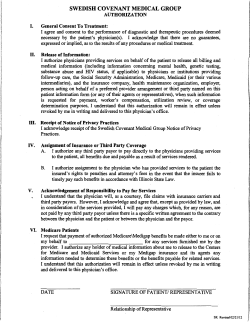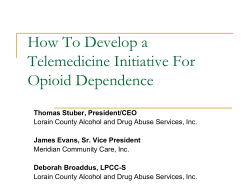
Reporter the IMPROPER PERFORMANCE: OB/GYN CLOSED CLAIM STUDY
the TEXAS MEDICAL LIABILITY TRUST Special issue: Obstetrics/gynecology 2003 Reporter IMPROPER PERFORMANCE: OB/GYN CLOSED CLAIM STUDY by Michele Luckie, Risk Management Representative The following closed claim study is based on an actual malpractice claim from Texas Medical Liability Trust. This case illustrates how action or inaction on the part of physicians led to allegations of professional liability, and how risk management techniques may have either prevented the outcome or increased the physician's defensibility. An attempt has been made to make the material less easy to identify. If you recognize your own case, please be assured it is presented solely for the purpose of emphasizing the issues of the case. Presentation The patient is a 26-year-old gravida 2 para 1 whose previous pregnancies resulted in the cesarean section delivery of twins 6 years earlier and an elective abortion the following year. She called her obstetrician to inform him of a positive home pregnancy test and schedule her initial prenatal exam. The patient presented for her first prenatal visit approximately one month later complaining of nausea and episodes of spotting and bleeding. A sonogram was performed which showed a healthy 14week fetus. There was no explanation for the spotting. She was started on prenatal vitamins and advised to decrease her activity until the bleeding stopped. When the patient was next seen, she was 18 weeks pregnant. She informed her physician that she felt she had been leaking fluid for approximately three weeks. The obstetrician obtained cultures for chlamydia, group B strep, and gonorrhea and all were negative. The patient did have a severe yeast infection and Diflucan was prescribed. A sonogram was performed that showed a lack of amniotic fluid around the fetus and a heart beat of 138. The patient was informed that because of the large amount of fluid lost, it was unlikely that the rupture would seal over and fluid reaccumulate. Termination of the pregnancy was discussed and the patent was advised to admit herself to the hospital for bed rest and monitoring of the infection. The patient refused and went home with instructions for strict bed rest and to take her temperature every 4 hours and notify the physician if it was over 100 degrees. She was to return in 3 days, NPO after midnight before her return, in order to proceed with the termination. When she returned to the office, she was still leaking fluid. A sonogram revealed severe oligohydramnios. Physician action The physician explained to the patient and her husband that there had been no reaccumulation of fluid and the pregnancy was not salvageable. He then discussed the termination options available. She could be induced, go into labor and deliver the fetus or undergo a D & E (dilation and evacuation). The risks and benefits of both methods were discussed and the patient decided to have the D & E. The patient was scheduled for surgery on the same day. The cervix was dilated and the endometrial cavity was suction curetted. Ringed forceps were then used to remove placental and fetal parts. During this process, a loop of intestine was pulled into the vaginal cavity with the suction curette. The physician realized that there had been a uterine perforation. Instrumentation was removed and a Pfannenstiel-type incision was made on the abdomen to repair the uterus. Once the uterus was identified, a posterior laceration that extended from nearly the fundus to the cervix was repaired. He next inspected the bowel and found a tear. Upon this finding, he called in a general surgeon to assist. The surgeon proceeded with an exploratory laparotomy and repaired a 10 cm laceration in the mesentery of the rectosigmoid colon. There was no perforation into the lumen of the rectosigmoid colon. The remainder of the procedure was without untoward event. The patient was discharged three days later with standard post-operative treatment instructions. She was to follow-up with the Ob/Gyn in 4 days. At 6:00 pm the following day, the patient presented to the ER and was seen by the defendant’s partner, who was on call. She was admitted for post-operative ileus. A naso-gastric tube was placed in the patient’s stomach for suctioning. Following a gastrografin enema, she experienced relief of her symptoms and the return of bowel function. She was discharged after six days. The physician next heard from the patient via telephone a month later complaining of bleeding and cramping. A partner saw her in the office three days later. His impression was mild metritis for which he prescribed Doxycycline and asked her to return in 7-10 days. The patient never filled the prescription and did not return to the office. No further follow-up was documented. After the plaintiff filed this claim, she sought care from another gynecologist after months of chronic pelvic pain. She subsequently underwent a laparotomy, lysis of adhesions, total abdominal hysterectomy and bilateral salpingo-oophorectomy. Allegations • Failure to employ a safer, more appropriate alternative to D&E • Failure to determine if the uterus was retroverted or antiverted prior to beginning the procedure • Failure to hospitalize the patient after the initial sonogram revealed significant loss of amniotic fluid • Failure to perform a Nitrazine test Legal principle Negligence is defined as the lack of ordinary care, i.e. the degree of care that a reasonably prudent physician would have exercised under the same or similar circumstances. When an allegation of negligence has been made, one of the four elements that must be proven is that the physician deviated from the accepted standard of care. The TMLT consultants were generally supportive of the care this patient received. However, they also expressed some concern about the physician’s experience in performing D & E procedures. While they agreed that dilation and evacuation is an accepted method of termination at 18 weeks, they also indicated that physicians who are very well trained and experienced in this type of procedure may be most appropriate to perform it. The defendant physician stated in his deposition that he performed one or two of these procedures a year. In addition, the consultants were critical of the lack of documentation about the discussion with the patient regarding the various approaches that could be taken to evacuate the uterus under the circumstances. They felt it could certainly be argued that, if she had understood 2 Obstetrics/gynecology there was a less traumatic or safer way to terminate the pregnancy, she would have chosen that over the D & E. The physician stated in his deposition that it is his practice to thoroughly discuss available treatment options with patients, but generally he does not document the discusssion in the patient record. Disposition This claim was settled on behalf of the physician for $150,000. Risk management considerations In this case, the doctor felt he was qualified to perform a D & E and proceeded in his care of the patient. However, consultants were concerned about the physician’s experience with this procedure. Unfortunately, a known surgical complication occurred. When a case like this results in a lawsuit, the informed consent process is often an issue. Poor documentation of this discussion with the patient can compromise the defense of a malpractice claim. Texas law places the responsibility for the informed consent process with the physician. The informed consent discussion should take place in the physician’s office whenever possible. This provides a more familiar atmosphere for the patient and takes away some of the anxiety of being in a hospital or outpatient surgery center when having this discussion. The associated risks, benefits, and alternatives to the treatment plan/procedure along with a reference to the conversation should be documented in the medical record and include the patient’s understanding and desire to proceed. Patients who don’t keep scheduled office appointments are a challenge for all medical practices. In this case, the physician stated that, when the patient did not return to the office as directed, he felt that she must have improved after taking the prescribed antibiotic. This, of course, was not the case. Patients don’t keep follow-up appointments for many reasons and sometimes it’s because they are unhappy with the care they have received. If no attempt is made to contact these patients and an adverse outcome occurs, the physician may be perceived as not caring. Does this mean that you need to call every patient who doesn’t keep an appointment? No, but it’s a good idea to have a process in place that ensures the charts of patients who did not keep scheduled appointments are reviewed for medical necessity and continuity of care. Document in the record that the patient was a “no show.” Patients with chronic conditions, post operative patients, and those whose condition require a revisit should be contacted either by phone or letter and reminded that it is important to their health to follow through with scheduled appointments. Documenting these calls or letters demonstrates your efforts to contact these patients should a problem arise. risk management 101 FDA: Hormones get box warning and label changes February 2003 The labeling of all estrogen and estrogen with progestin products for use by postmenopausal women will undergo important safety changes. Those changes reflect the FDA’s analysis of data from an arm of the Women’s Health Initiative that raised concerns last summer and are part of a series of actions to provide advice to physicians who prescribe these products and risk management information to women. “FDA’s actions will help inform health care providers and their patients so that they can appropriately balance the benefits and risks to make the best possible decisions about use of these drugs,” said FDA Commissioner Mark McClellan, MD, PhD. In addition, the agency issued a new boxed warning that reflects the new risk information. It also outlines specific changes to indications for which these products are approved. Overall, these warning and label changes are designed to emphasize the importance of individualized decisions that appropriately balance the benefits and the potential risks involved. The boxed warning, the highest level of warning information in labeling, also highlights the increased risks for heart disease, heart attacks, strokes, and breast cancer associated with these hormones. It notes that these products are not approved for heart disease prevention. Approved indications also have been modified to clarify that the drugs should be used only when the benefits clearly outweigh the risks. For instance, when prescribed solely for the prevention of postmenopausal osteoporosis, approved nonestrogen treatments should be carefully considered first. While the FDA did not make any modification for the treatment of moderate to severe vasomotor symptoms, it did advise prescribing these therapies at the lowest dose for the shortest duration of time. The FDA is asking all manufacturers of estrogen and estrogen-progestin products to add similar warnings and change the enclosed patient information leaflet because all hormone products are believed to carry similar health risks. With quality patient care and prudent risk management in mind, the basic tenets of sound medical decision making should be followed in evaluating patients regarding their options for HRT. In assessing whether patients should begin or continue a regimen of HRT, a thorough history and physical including family and social history as well as any risk factors, should be completed and documented. A comprehensive discussion regarding not only the outcome of the WHI study but also any other pertinent available information should be discussed. The risks, benefits and alternative therapies should be discussed. Everything should be comprehensively documented in the patient record including the patient’s understanding of the information presented, along with a note indicating the patient’s informed consent and decision regarding treatment. Sources 1. www.fda.gov 2. Rossouw, J., MBChB, MD, et al., Risks and Benefits of Estrogen Plus Progestin in Healthy Postmenopausal Women, JAMA, July 17, 2002, 321-333. ACOG opinion regarding GBS screening The Centers for Disease Control and Prevention (CDC) released revised guidelines in 2002 for GBS perinatal disease. These new guidelines replace those issued in 1996 and have a significant impact on all obstetricians and pediatricians. The change in clinical practice follows new data and recommendations from the CDC which show routine prenatal screening is more effective than the risk-based approach. Results have shown far fewer cases of early-onset group B strep disease in newborns (occurring during the first week of life). Vaginal and rectal GBS screening cultures should be performed at 35 to 37 weeks gestation on all pregnant women except for those who had GBS bacteriuria during the current pregnancy or gave birth to a previous infant with invasive GBS dis- ease. These patients should receive prophylaxis regardless of the result of any vaginal culture. The risk factor approach is no longer recommended unless a vaginal/rectal culture has not been performed. Patients with an unknown GBS status (culture not done or not ready) should receive intrapartum prophylaxis if delivery is before 37 weeks gestation, if rupture of membranes is 18 hours or longer, or if the intrapartum temperature is 100.4 degrees or above. “We now have strong evidence to make the case that routine screening for GBS is the superior method in preventing transmission of the bacteria from mother to child during delivery,” notes Laura E. Riley, MD, an infectious disease specialist and chair of ACOG’s Committee on Obstetric Practice. The committee’s opin- ion supports the CDC’s revised guidelines that a screening based approach for the prevention of early onset GBS disease in the newborn be adopted. “We have achieved great success in reducing the transmission of infectious diseases from mothers to newborns in recent years. By recommending universal GBS screening of all pregnant women, we look to further decrease perinatal morbidity and mortality rates in this country,” notes Riley. Sources 1. Cole, David, Bernstein, Peter S., Medscape Ob/Gyn & Women’s Health, An update on perinatal Group B streptococcal Disease, posted 11/14/02. 2. www.acog.org, ACOG News Release, November 29, 2002. Obstetrics/gynecology 3 Pre-sorted Standard U.S. Postage PAID Permit No. 90 Austin, Texas the Reporter TEXAS MEDICAL LIABILITY TRUST P.O. Box 160140 Austin, TX 78716-0140 800-580-8658 or 512-425-5800 Fax: 512-425-5998 E-mail: barbara-rose@tmlt.org Web address: www.tmlt.org Editor Jane Mueller Managing Editor Barbara Rose Contributing Editor Michele Luckie The Reporter is published by Texas Medical Liability Trust as an information and educational service to TMLT policyholders. All articles and any forms, checklists, guidelines and materials are for general information only, and should not be used or referred to as primary legal sources nor construed as establishing medical standards of care. They are intended as resources to be selectively used and always adapted — with the advice of the organization’s attorney — to meet state, local, individual organizations and department needs or requirements. The Reporter is distributed with the understanding that Texas Medical Liability Trust is not engaged in rendering legal services. © 2003 TMLT PIAA Release Senate Holds Hearing, Insurance Industry Experts Dispel Medical Malpractice Myths in D. C. Press Conference Rockville, MD February 12, 2003 Three insurance industry trade groups came together 2/11/2003 to set the record straight on the causes of the current medical malpractice crisis. The Physician Insurers Association of America (PIAA), the Insurance Information Institute (III), and the Alliance of American Insurers (AAI) presented statistical evidence that clearly places responsibility for the current medical liability and health care accessibility crisis on the shoulders of a dysfunctional tort system and its out-of-control costs. A series of exhibits showed the escalation of jury awards and settlements, the strength of medical malpractice insurers’ investment portfolios, and the rising costs to the health care system of the vast numbers of meritless malpractice cases that are filed every year. Stated Larry Smarr, PIAA President, “We realize that this is an emotional issue for many, including those for whom the services of doctors are increasingly unavailable. If the facts can get as 4 Obstetrics/gynecology much air time as the myths and soundbytes, I am confident we will find an effective solution to this national problem.” In addition, the group presented strong statistical support for caps on non-economic damages, showing the lower premiums paid by doctors in states with strong tort reforms already in place. For example, in California, Kansas, and Colorado, caps on non-economic damages and other tort reform measures have resulted in a more stable and predictable insurance market, which has translated to lower premiums for physicians in those states. Mr. Smarr also presented similar evidence at a Senate hearing on the medical liability crisis later in the afternoon. There he testified that from 1992 to 2001, the average claim payment amount has risen at a compound annual growth rate of 6.9 percent as compared to 2.6 percent for the CPIU. A complete transcript of this press conference is available at www.thepiaa.org. Got R is k? Identifying the common risk exposures in your medical practice Who should attend? This seminar is intended for medical office staff including nursing staff, office managers, front office staff, and medical records personnel. Registration To register or for more information, contact Natalie Gilmore at 800-580-8658 ext. 5911 or e-mail natalie-gilmore@tmlt.org. Thursday, April 3 Bexar CMS San Antonio, TX Thursday, April 10 Rancho Viejo Country Club Harlingen, TX Thursday, April 17 Tyler Sheraton Tyler, TX Thursday, April 24 Norris Conference Center Austin, TX Tuesday, April 29 Harris CMS, Museum of Health & Medical Science Houston, TX Tuesday, May 6 Dallas CMS Dallas, TX Wednesday, May 7 Tarrant CMS Fort Worth, TX
© Copyright 2025





















